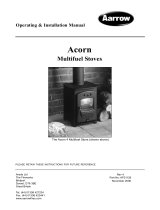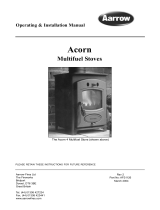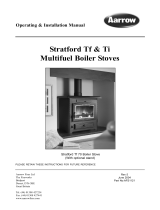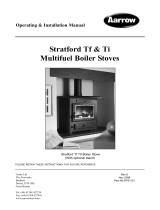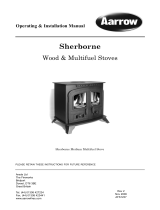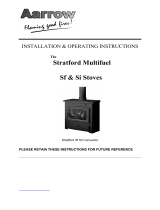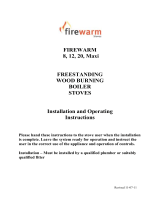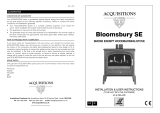Page is loading ...

Wood / Multifuel Model Range
Operating & Installation Manual
PLEASE RETAIN THESE INSTRUCTIONS FOR FUTURE REFERENCE
Ecoburn 7 Multifuel
Rev 6
October 2006
AFS1221
BK043

Congratulations on your choice of an Aarrow Stove.
More than 20 years experience has been put into the
development of our Ecoburn range to ensure ultimate
performance and years of trouble free enjoyment.
Every detail on this stove has been carefully engineered
and designed which is why we are so confident in the
reliability of our product that we offer a
Lifetime Guarantee.
Should you have any questions about our Ecoburn Stoves
that are not covered in this manual, please contact the
Aarrow dealer in your area, or call our Technical support
department on 01308 427234
2 Aarrow Ecoburn Wood & Multifuel Stoves
© COPYRIGHT 2006
Arada Ltd
This booklet has copyright & may not be
copied in whole or part or be used for any
purpose other than that for which it is
supplied without express written consent
from Arada Limited.

INTRODUCTION Page
Warning Notice 4
Safety Notices 5
The Principle Of The Fire 5
Check List 6 - 7
Technical Data 8
INST
ALLATION
General Precautions 9
Handling 9
Hearth 9
Combustible Materials 9
Air For Combustion 9
Fitting the Flue Outlet & Hotplate 10
Flues & Chimneys 10 - 13
Adjusting the Self Levelling Feet 14
Wood Only Version 14
Multifuel Version 15
Firebox Liner Panels 16
Optional Add In Boilers 17
Water Connections 17 - 18
Final Check List 19
SER
VICING & MAINTENANCE
Cleaning - Internal Surfaces 20
Cleaning - Outer Finish 20
Chimney Sweeping 20
Annual Maintenance 21
Summer Storage / Non Usage 21
Door Adjustment 21
Dissassemble Airwash 22
Fuel Retaining Bars - Inspection 22
Fire Door Glass 23
Service Record 24
OPERA
TING INSTRUCTIONS
Fuel Types 25
Lighting The Fire 25
Solid Fuel Burning 26
Burning Wood 26
Mixed Fuels 26
Anthracite 26
Overnight Burning 26
Air Inlet Controls - Primary Air 27
Air Inlet Controls - Airwash 27
Fuel Retainer Bars 27
Multi-Purpose Operating Tool 28
Setting The Grate 28
De-Ashing (Riddle) 28
Empty The Ashpan 28
Ash Removal 28
Adjusting Air Inlet Controls 28
Main Fire Door Handle 29
Over-Firing 29
Extended Burning 29
O
PTIONAL EXTRA ACCESSORIES 30
SPARE PARTS LIST 31 - 33
GUARANTEE 34 - 35
FINAL FACTORY CHECKLIST 36
Aarrow Ecoburn Wood & Multifuel Stoves 3
CONTENTS

WARNING
T O ALL MULTIFUEL USERS
PETROLEUM COKE
SOME OF WHOSE BRAND NAMES ARE
"CALCO", "PETROCOKE" OR "WONDERCO"
MUST NOT BE BURNED IN THIS APPLIANCE
TO USE THESE FUELS WILL INVALIDATE THE
APPLIANCE GUARANTEE
IF IN DOUBT CONTACT THE SOLID FUEL ASSOCIATION
TELEPHONE NUMBER 0800 600 000
www.solidfuel.co.uk
THE USE OF SPARE PARTS OTHER THAN THOSE SUPPLIED
BY AARROW FIRES WILL INVALIDATE THE
APPLIANCE GUARANTEE.
4 Aarrow Ecoburn Wood & Multifuel Stoves

Aarrow Ecoburn Wood & Multifuel Stoves 5
INTRODUCTION
SAFETY
A fireguard conforming to BS 8423: 2002 should
be used in the presence of children and old/or
infirm people. If the appliance is used with the fire
door open, a spark guard conforming to BS 3248
should be fitted.
Caution -
Do not use aerosol sprays or any other flamma-
ble materials near the appliance under fire.
Do not fit an extractor fan in the same room as
the appliance.
Fire cement is caustic, hand and eye protection
should always be worn, prolonged contact with
the skin should be avoided.
Aarrow Fires Ltd will not be responsible for any
consequential or incidental loss or injury
however caused.
Before continuing any further with the installation
of this appliance please read the following guide to
manual handling.
• Always obtain assistance when lifting the
appliance.
• When lifting always keep your back
straight. Bend your legs not your back.
• Avoid twisting at the waist. It is better to
reposition your feet.
• Avoid upper body/top heavy bending. Do not
lean forwards or sideways when
handling the fire.
• Always grip with the palms of your hands.
Do not use fingertips for support.
• Always keep the stove as close to the body as
possible. This will minimise the cantilever
action.
• Use gloves to provide additional grip.
THE PRINCIPLE OF THE FIRE
Your Aarrow stove is built to the highest standard
of craftsmanship using the best materials and the
most modern equipment available. It is a highly
efficient and sophisticated piece of machinery and
when properly installed and operated it should pro-
vide a lifetime of heating satisfaction.
Safety is the most important consideration when
installing your fire. If not properly installed and
operated a house fire may result. installation must
comply with the Building Regulations and conform
to all relevant fire safety standards.
Aarrow Fires produce a variety of appliances
ranging from units, which are traditional in style to
stoves which are modern in appearance, all
bristling with "High Tech" features.
Model types include simple room heaters,
convectors, integral boiler models and inset units.
Your Aarrow Stove, is constructed from either sin-
gle or twin wall steel strengthened where necessary.
Cast iron is used where appropriate for decorative
features.
All fire doors are fitted with special high
temperature ceramic glass panels through which
the fire can be viewed.
Multifuel stoves are fitted with a cast iron grate to
give full multifuel facility and positive de-ashing.
All models except integral boiler models are lined
with firebricks or heat reflective panels which
ensure complete combustion and provide a good
heat store to even out fluctuations in burning.
An internal throat plate produces turbulence to
encourage secondary combustion and directs the
flue gas around the whole upper firebox before
allowing it to escape up the chimney.
On multifuel appliances the primary air for burning
enters the ash pit chamber beneath the grate,
controlled by the air inlet mechanism.
Aarrow stoves are also fitted with an "air wash" so
called because it provides a curtain of high speed
preheated air behind the glass to help keep it clean
and to provide secondary air/over draught.
The provision of two inlets on all multifuel stoves
gives a wide range of primary air/secondary air,
under draught/over draught combinations. The
optimum settings will only be established by
experience in firing the appliance, and will depend
on type of fuel, the position of the appliance in the
house, condition of chimney etc.

6 Aarrow Ecoburn Wood & Multifuel Stoves
CHECK LIST
5
Part Description
& Visual Aid
(not to scale)
ECB 5
Multifuel
4. Flue spigot
1 (4”)
5. Hotplate
6. Rear liner (s)
7. Side liners
2
N/A
ECB 7
Wood
1 (5”)
2
2
ECB 7
Multifuel
N/A
ECB 5
Wood
1 (4”)
2
7
1 (5”)
2
ECB 9
Wood
ECB 9
Multifuel
2
1(4”)
1(5”)
1 (4”)
1(5”)
1. Grate bars
1
1
2. Wood burning
tray
ECB 11
Multifuel
ECB 11
Wood
3. Stainless Steel
Throat plate
1
11
1
1
1
N/AN/A
9
1 (5”)
2
N/A
1 (6”)
2
2
N/A
1 (5”)
2
11
1 (6”)
2
2
1(5”)
1(6”)
1 (5”)
1(6”)
1
1
1
11
1
2
2
N/AN/A

Aarrow Ecoburn Wood & Multifuel Stoves 7
CHECK LIST
2
1
2
2
10. Fuel retainers
2
1
1
1
Part Description
& Visual Aid
(not to scale)
14. Instruction
Manual
13. Operating tool
1
1
1
1
1
8. Rear grate bar
support
11. Fire door han-
dle - Nickel Plated
1 1
1
9. Comb
assembly
consisting
of comb & comb
extension
bar
1
N/A
N/A
1N/A1
1
1N/A
1
1
1
15. Stove Mitten
2
1
2
2
2
1
1
1
1
1
1
1
1
1
1
1
1
N/A
N/A
1N/A1
1
1
N/A
1
1
1
1
1
1
1
1 1
1
1
ECB 5
Multifuel
ECB 7
Wood
ECB 7
Multifuel
ECB 5
Wood
ECB 9
Wood
ECB 9
Multifuel
ECB 11
Multifuel
ECB 11
Wood
12. Stainless steel
Ashpan & Cover

8 Aarrow Ecoburn Wood & Multifuel Stoves
TECHNICAL DATA
Room Min/Max
Room Heater Only
Output (kW)
1 - 5
TECHNICAL DATA
Room Heater with Domestic Hot
Water with add in boiler type
0
Max Output to Room (kW)
Max Output to Water (kW)
3
2
Height (mm)
Width (mm)
Depth (mm) *
Height to Centre of Rear Flue
Depth from Back to Centre
of Flue (mm)
Flue Diameter
Weight Packed (Kg)
1 - 7
8
4.8
2.2
1 - 5
3
2
1 - 7
8
4.8
2.2
*Measured from rear of canopy to the tip of the handle.
The model and Serial Number of your stove can be found stamped into the casing,
centrally just below the bottom edge of the fire door aperture.
522
522
558
558
476476
397397
388
388
386
386
449
109
68
449
424
424
0
109
64
94
5754
102mm
(4”)
94
102mm
(4”)
127mm
(5”)
127mm
(5”)
ECB 5
Multifuel
ECB 7
Wood
ECB 7
Multifuel
ECB 5
Wood
ECB 9
Wood
ECB 9
Multifuel
ECB 11
Multifuel
ECB 11
Wood
2 - 9
9
6.7
2.3
2.5 - 11
10
7.6
3.4
2 - 9
6.7
2.3
2.5 - 11
10
7.6
3.4
600
600
605
605
672672
586
586
396 396
442 442
478.5
141
478.5
485485
9
141
102.5
127mm
(5”)
102.5
127mm
(5”)
152mm
(6”)
152mm
(6”)
106
95
79
74

Aarrow Ecoburn Wood & Multifuel Stoves 9
INSTALLATION
GENERAL PRECAUTIONS
Note - All installations must conform to the
appropriate building regulations.
The Building Regulations for England and Wales
2000 ref Approved Document J 2002 edition
(issued by the DTLR).
The Building Standards (Scotland) (Consolidation)
Regulations.
Detailed recommendations for installation of
appliances, chimneys and flues are outlined in the
current issue of the following British Standards:-
BS6461, BS8303 and BS4543.
Any Manufacturer's Instructions must not be
taken as overriding statutory requirements.
During installation ensure that adequate
precautions are taken to avoid unnecessary risk to
yourself or any householder. In particular the
danger from the caustic nature of the fire cement
should be avoided by using these accepted
methods:
• Wear gloves when handling fire cement.
• Wear goggles when chiselling or looking up
chimneys.
Make sure that Building Regulations are adhered to
during installation along with any local by-laws. In
the case of heating systems make sure that the pipe
work is correctly bonded to ensure electrical
earthing.
HANDLING
By the time you read this you will appreciate the
weight of the appliance. The Safety and handling
guidelines as set out on page 5 of this manual
should be followed.
To make movement easier internal fittings, fuel
retainers, grates, firebox liners, flue outlets, hot
plate, throat plate, etc., can be removed.
Care should be taken to make sure that the hinges
are not damaged during installation.
HEARTH
The stove should be installed to stand on a
constructional hearth of non-combustible materials
not less than 125mm (5'') thick conforming to
Building Regulations. Dimensions of the hearth
should project at least 300mm (12'') forward of the
front of the appliance and 150mm (6'') at the sides.
The surface of the hearth should be free of
combustible materials. In most buildings with solid
concrete floors the requirement will be met by the
floor itself, but mark the perimeter of the hearth to
ensure floor coverings are kept well away or use
different levels to mark the hearth perimeter.
COMBUSTIBLE MATERIALS
A gap of at least 450mm (18'') should be allowed
between the appliance and any combustible
materials including furnishings. Adjacent walls
should be of suitable non-combustible
construction, preferably brickwork. In large
fireplaces take care that any supporting beam is
protected by a 13mm (0.5'') sheet of
Masterboard/Supalux spaced 13mm (0.5'') off the
surface with strips of non-combustible material
- not wood.
Make sure that there is a gap between an
uninsulated flue system and any combustible
material. This gap must be at least 3 x the outside
diameter of the flue pipe, or 1.5 x the flue diameter
to non combustible surfaces. see illustration p13.
AIR FOR COMBUSTION
There must always be a permanent means of
providing air for combustion into the room in
which the fire is installed. A permanent vent with a
total free area of at least 550mm
2
for every kW
rated output above 5kw should be connected
directly to the outside air or to an adjacent room
which itself has a permanent vent of the same size
direct to the outside air. The fitting of an extractor
fan to either of these rooms is not recommended.

10 Aarrow Ecoburn Wood & Multifuel Stoves
INSTALLATION
FITTING THE FLUE OUTLET AND
HOT PLATE
The flue outlet spigot is found packed inside the
appliance. The hot plate (blanking plate) is supplied
fitted to the top opening and is removed by turning
clockwise (as is the flue outlet).
Smear a very thin layer of fire cement on the faces
of the flue outlet and the blanking plate. Fit the out-
let to the appliance in the desired position .
Lock into place by rotating anti-clockwise and
tighten by tapping with a block of wood and mallet
from the inside of the appliance. Similarly, fit the
blanking plate to the unused opening. Clean off any
surplus fire cement.
Place appliance on the hearth and make sure that it
is level and does not rock. The Solution range of
stoves are fitted with adjustment cam on both rear
legs, see page 14 for details.
Connect the chimney ensuring all joints are sealed
with fire cement.
Fig. 1. Flue and Spigot Fitting
FLUES AND CHIMNEYS
Please remember that chimney draught is
dependent on four main factors:
• Flue gas temperature.
• Flue height.
• Flue size.
• Flue terminal.
The stove must be connected to a suitable and
efficient flue that provides a good up draught to
safely take the products of combustion (fumes)
from the stove outlet to the outside air. To ensure a
good up draught it is important that the flue gases
are kept warm and that the flue size suits the stove.
The termination of the outlet at the top of the flue
also needs to comply with the Building
Regulations. The minimum effective height of the
flue must be at least 4.5 metres from the top of the
stove to the top of the flue outlet. When warm the
flue draught should be between 0.1 and 0.2 mb.
A chimney may comply with the regulations but
still be subject to down draught and similar
problems. A chimney terminating above the ridge
level is generally less likely to suffer such
problems.
If a new chimney is being provided it should fully
comply with the relevant Building Regulations that
specify the requirements for solid fuel burning
installations. Suitable types of chimney include the
following.
Masonry chimney built with clay or concrete
liners, or a chimney block system meeting Building
Regulations. These types of chimney should be
installed in accordance with the Building
Regulations and BS 6461: Part 1.
Factory made insulated chimney complying
with BS 4543: Part 2 (often called "Class 1
prefabricated metal chimney"). These types of
chimney should be installed in accordance with the
Building Regulations and BS 7566: Parts 1 to 4.
*NOTE
THE FLU E PIPE MUST B E FITTED INSIDE THE O UTLET SP IGOT
FAILURE TO DO SO COULD RESULT IN THE SPILLAGE OF
CONDENSATION ECT . RUNNING DOWN THE FLUE.

Due to the gradual introduction of European
Chimney Standards chimneys will be specified
according to their performance designation as
defined in BS EN 1443 that covers the General
Requirements for chimneys. The minimum
performance designation required for use with solid
fuel burning stoves is T450 N2 S D3.
The flue and chimney installation must be carefully
checked by a competent person before fitting the
stove to ensure it is suitable and will work safely.
If the chimney is old (i.e. built of brick or stone
without a liner) or being opened up for reuse
additional checks and smoke testing as described in
Appendix E of the Approved Document J 2002
Edition should also be carried out to ensure the flue
and chimney are in good operating condition.
Unless the existing flue is in good condition with
suitable access for collection and removal of debris.
If the flue size is more than 225mm (9 inches)
diameter or 200 x 200mm square, a suitable lining of
150mm (6 inches) diameter should be fitted, or if the
flue length is over 5.5 metres one size larger than the
appliance outlet should be fitted. This should be a
double skin stainless steel flexible flue liner that is
independently certified for use with solid fuel.
Details of suitable linings for use with solid fuel are
given in the Official HETAS guide that can be
viewed on their website at www.hetas.co.uk
It is also important that suitable flue pipe
complying with the Building Regulations is used to
connect the stove to the flue in the chimney and that
suitable access is provided into the flue for regular
inspection and sweeping of the flueways.
The installer should comply with the Building
Regulation requirements in respect of providing a
Notice Plate giving details on the chimney, flue
lining, hearth and fireplace installation. Approved
Document J of the Building Regulations for
England and Wales is available from The Stationery
Book shops and can also be
viewed at the ODPM website at
www.safety.odpm.gov.uk/bregs/brads.htm
Details on the relevant Building Regulations and
BS British Standards are given in the "General
Precautions" section page 9 of these instructions.
A chimney may comply with the regulations but
still be subject to down draught and similar
problems. A chimney terminating above the ridge
level is generally less likely to suffer such
problems.
Chimneys should be as straight as possible.
Horizontal runs should be avoided except where
the rear outlet of the appliance is used, in which
case the horizontal section should not exceed
150mm (6'') in length.
If the fire appears to be working hard but produces
very little output to the room it is likely that
excessive draw is present in the chimney, and that
heat is being sucked out of the appliance and up the
chimney. If this is the case we recommend the
fitting of a draught stabiliser in preference to a flue
damper, in the interest of safety and efficiency.
We do not recommend the use of a damper when
burning solid fuel.
FOR ALL APPLIANCES
Access for cleaning the flue should be incorporated
in the system other than through the appliance (e.g.
a soot door or access through register plate).
Purpose-made soot doors and inspection lengths
are available from manufacturers of all systems.
Ensure that the whole length of the flue can be
reached from the soot door.
Note: if the appliance is fitted with a draught
stabiliser or if one is fitted to the flue pipe or
chimney in the same room as the appliance, then
the permanent air entry opening (or openings)
should be increased by 300mm
2
for each kW of
rated output.
For advice on flues and chimneys contact;
NACE (National Association of Chimney
Engineer): telephone 0800 0924019
www.nace.org.uk
or
NACS (National Association of Chimney
Sweeps): telephone 01785 811732
www.chimneyworks.co.uk
Aarrow Ecoburn Wood & Multifuel Stoves 11
INSTALLATION

12 Aarrow Ecoburn Wood & Mutifuel Stoves
INSTALLATION
Fig. 2. A Typical Rear Flue Layout


14 Aarrow Ecoburn Wood & Multifuel Stoves
INSTALLATION
ADJUSTING THE SELF
LEVELLING FEET
The Aarrow Ecoburn Wood and Multifuel stoves
are equipped with adjustable rear levelling feet,
these are ideal for use where the hearth surface is
not flat or level.
Adjustment is as follows:
• Position the stove on the hearth into its final rest-
ing place, ensuring room for the flue connections
etc.
• On the rear leg of the stove, loosen the pozi screw,
and rotate the inner ‘cam’ shaped levelling foot
until this touches the hearth. (See Fig. 4.).
•Re-tighten the pozi screw. Check the stove is level
with a sprit level.
•Repeat for the other rear leg.
WOOD STOVE VERSION -
WOOD TRAY
The wood burning tray should come fitted in your
stove, if not please follow these instructions -
•Fully open the fire door , and remove the two round
fuel retaining bars,
•Locate the front of the wood tray, this is the end
with no tabs protruding from each side,opposite to
the rear end with the tabs protruding either
side.(See Fig. 5.)
•Holding the front edge of the wood tray, carefully
insert the wood tray into the firebox, taking care not
to damage the paint work and side / rear liner pan-
els.
•Engage the rear lugs into the slots athe the rear of
the side landings. Then lower the front of the tray
until this rests onto the front brace of the stove.
(See Fig. 6.)
Fig. 4. Adjusting the rear feet
Front
Rear Lug
Fig. 5. Wood tray identification
Fig. 6. Wood Tray Installed

MULTIFUEL STOVE VERSION-
MULTIFUEL GRATE
GRATE
The grates in the Aarrow Ecoburn multifuel units
comprise a series of reciprocating cast iron bars
seated on a pivoted "comb". All bars in the grate are
identical, but every other bar is turned through 180
degrees, with the ends of the bars marked "H" sit-
ting on the high sections of the comb, and the ends
marked "L" sitting on the low sections.
ASSEMBLING THE GRATE
To assemble the grate, fit bars to low sections of the
comb first, inserting end marked "H" into rear
channel with groove on underside of bar located on
upstand tab, and then lowering end marked "L"
onto the low section of the comb, see fig. 7. The
upper bar is fitted in a similar manner, but with the
end marked "L" inserted in the rear channel, and
the end marked "H" seated on the high section of
the comb. See fig. 8. for the assembled grate layout.
GRATE BAR REPLACEMENT
After extended use it may be necessary to replace
some of the grate bars. Periodic inspection of the
bars is recommended and the removal of any nails
or wire that may be present after burning wood. All
the grate bars in each appliance are identical and
can easily be lifted out after removal of the fuel
retainers. Remove damaged grate bars and replace
with casting of the same type, fitting as per
instruction above. When re-ordering replacement
grate bars, see page 31of these instructions for the
correct spare part code.
Aarrow Ecoburn Wood & Multifuel Stoves 15
INSTALLATION
Fig. 7. Fitting the grate bars
Fig. 8. Assembled grate

16 Aarrow Ecoburn Wood & Multifuel Stoves
INSTALLATION
FIREBOX LINER PANELS
The Aarrow Ecoburn Wood and Multifuel stoves
use firebox liner panels to the sides and back of the
firebox. The throat plate sits on top of the side and
rear panels. These should come fitted to your stove,
if however they are not proceed as follows to fit
them as follows -
•Open the fire door.
•Remove the two round front fuel retaining bars, by
lifting one end free of the bracket and sliding the
remaining end out from the bracket.
•Set the small liner(s) into the back of the fire.
•Insert side liner panels. (See Fig. 10).
•Fit the throat plate with the single bend and two
cut outs to the front facing up. The projecting lugs
sit on top of the side liners. The long centre tab on
the back edge rests on the rear liners.The shorter
turn-down tabs against the vertical face.(See Fig.
11 & 12 ).
•Replace the front fuel retainer bars.
Note: Neither the rear firebox liners nor the side
firebox liners are "handed", both faces are
suitable for direct contact with the fire.
Note: Cracking of lining panels does not effect
efficiency.
Fig. 9. Overall View Of Liners & Throat
Plate.
Fig. 10. Liners inserted
Fig. 11. Inserting the throat plate
Fig. 12. Liners & throat plate
correctly fitted

Aarrow Ecoburn Wood & Multifuel Stoves 17
INSTALLATION
OPTIONAL ADD IN BOILERS
Aarrow Ecoburn Wood and Multifuel stoves offer
the option of a slab boiler, which occupies the posi-
tion of the rear firebox liner panels.
Fitting:
•Remove the fuel retainering bars, rear firebox liner
panels and throat plate.
•Knock out the blanking discs in the back
plate corresponding to the terminals on the
boiler.
•Introduce the boiler to the appliance
through the main fire door and locate the
terminal pipes through the back plate holes
and seal around boiler terminals with fire
cement.
•Engage locking nuts to the thread of the
terminals and tighten to secure the boiler in
position, ready for connection to flow and
return pipes.
•Replace throat plate and the fuel retainering bars.
Note: On boilers the terminal which is
approximately flush with the edge of the boiler
and marked "TOP" must be fitted uppermost, to
prevent "Kettling".
WATER CONNECTIONS
Heating systems
The size of the heating system which can be run,
will depend on the output rating of the appliance. It
will be necessary to work out heat loss calculations
for the system proposed in order to establish the
kW/hr rating. An appliance that will meet this
figure can then be chosen; (for boiler outputs please
refer to the brochure).
The constructional requirements of installing and
connecting the appliance also need to be taken into
account when selecting. Design and calculations
for individual heating systems should be carried out
by a qualified heating engineer. In many cases your
supplier will be able to offer advice and assistance.
Direct Systems
Stainless steel boilers, either factory fitted or
retro-fitted as add-in boilers enable connection to
direct systems to be made without the need to
change the cylinder or to fit an expansion tank. This
applies to domestic water supply only and should
not be done when in an area with soft water. If
radiators are used then an indirect system must be
utilised.
To connect the cylinder use 28mm copper pipes.
Ensure that the pipes rise continuously to the
cylinder.
Ensure that the runs are not too long, i.e. 20ft
maximum each for flow and return. Install the
cylinder above the level of the fire, and as close to
it as possible. (the higher the cylinder the faster the
circulation). Ensure that no valves are present in the
circulating pipes.
Indirect Systems- The Domestic Hot Water
Circuit
In addition to providing hot water the primary
circuit is essential in providing a "heat leak" to
absorb excessive heat produced in the event of the
circulation pump shutting down.
Heat is produced in varying quantities while the
fire is alight and care must be taken to ensure that
effective circulation can occur around the primary
circuit to carry heat away and thus stop boiling. The
output of any radiator installed as a "heat leak"
should not be less than 10% of the rated output of
the appliance. The radiator should not
be fitted
with a control valve.
The cylinder must be of the indirect type with a
minimum capacity of 110 litres, conforming to
BS 1566 part 1.

18 Aarrow Ecoburn Wood & Multifuel Stoves
INSTALLATION
Primary flow and return pipes should be 28mm
diameter. The cylinder should be installed at a
higher level than the appliance, and as close to it as
possible (the higher the cylinder the faster the
circulation). The flow and return pipes should not
be longer than 20ft each. Pipe runs should rise
continually from the boiler to the cylinder.
A radiator of approximately 25 sq.ft. should be
connected into the primary circuit, if installed in the
bathroom it provides a means of drying towels in
the summer.
Safety Vent Circuit
This circuit consists of a cold feed pipe, expansion
pipe, and expansion tank. The possibility that water
may boil can never be completely ruled out, and it
is therefore vital to ensure that cold water can be
supplied to the boiler and steam vented from it at all
times.
The expansion tank should have a capacity of at
least 7 % of the system's water capacity. The cold
water feed pipe should be at least 22mm diameter.
There must not be any shut off valves in the circuit.
Pipes should be run to avoid air locks. A spring
safety valve should be fitted to the expansion pipe
close to the boiler.
It is often possible, and is good practice, to utilise
the primary flow and return as part of the safety
circuit. The ball valve should have a copper ball.
The overflow pipe from the expansion tank should
be 28mm diameter copper. Pipes in unheated
spaces must be lagged.
FINAL CHECK
Before handing over the installation to the
customer it is strongly recommended that the
appliance is lit and the functioning of the chimney,
hot water and heating system is checked.
A checklist (Pre-lighting Checks) appears in the
Operating Instructions, but in addition to this the
installer should:
•Operate the heating system and set the
pump head.
•Balance the radiators.
•Re-vent and ensure no air locks.
•Check the circulation round the primary
system and the heat leak radiator,
particularly when the pump is running, to
ensure circulation is not reversed.
•Be sure that the chimney is operating and
that ALL smoke and fumes are vented to
the atmosphere through the chimney
terminal.
•Check all joints and seals.
•Clean the outside of the appliance to
prevent any stains becoming burnt on.
•Check the flue draught which should read
1 - 2mm, or 0.1 - 0.2mbar.
The following details must
be checked and
completed in full by the installer at the time of
installation. Please answer all questions as fully as
possible. Aarrow Fires can not be held responsi-
ble for chimney or installation.
HOT WATER SYSTEMS
Is the boiler cross-flowed? YES / NO
Are the pipes correctly sized? YES / NO
What is the calculated output
required to heat the system?
Is a heat leak fitted? YES / NO
What is the return water temperature?
Is the pump thermostatically
controlled by a pipe stat? YES / NO
What is the height and distance of the
hot water tank above the stove?

Aarrow Ecoburn Wood & Multifuel Stoves 19
INSTALLATION
CHECKLIST
Hearths, Fireplaces, Flues and chimneys
This checklist is to ensure hearths, fireplaces, flues and chimneys are satisfactory, and to show what you have done to comply with the
requirements of The Building Regulations 2000 Approved Document J 2002.
1. Building address, where work has been carried out.......................................................................................................................................
.........................................................................................................................................................................................................................
2. Identification of hearth, fireplace chimney or flue
3. Firing capability: solid fuel/gas/.
4. Intended type of appliance.
State model and output.
5. Ventilation provisions for the appliance:
State type and area of permanently open vents.
6. Chimney or flue construction
a) State the type or make and whether new or existing.
b) internal flue size (and equivalent height, where
calculated - natural draught gas appliances only).
c) If clay or concrete flue liners used confirm that they are
correctly jointed with socket end uppermost and
state jointing materials used.
d) If an existing chimney has been refurbished with a
new liner, type or make of liner fitted.
e) Details of flue outlet terminal and diagram reference.
Outlet Details:
Complies with:
f) Number and angle of bends.
g) Provision for cleaning and recommended frequency.
7. Hearth. Form of construction. New or existing?
8. Inspection and testing after completion
Tests carried out by:
Tests and results
Flue visual
inspection sweeping
coring ball
smoke
Appliance (where included) spillage
I/we the undersigned confirm that the above details are correct. In my opinion, these works comply with the relevant requirements in
Part J of Schedule 1 to the Building regulations.
Print name and title....................................................................................................Profession..........................................................................
Capacity......................................................................................................................Telephone..........................................................................
Address............................................................................................................................................................Post code.......................................
Signed........................................................................................................Date.................................

20 Aarrow Ecoburn Wood & Multifuel Stoves
SERVICING & MAINTENANCE
CLEANING
INTERNAL SURFACES
IMPORTANT -
Under some circumstances soot can quickly build
up on the throat plate and adjacent areas. The throat
plate should be removed and checked monthly, and
any debris stripped off. Similarly, clean the upper
surface of the firebox. Refer to page 16 for instruc-
tions on the throat plate removal / inspections.
OUTER FINISH
The outside finish of the appliance is a durable high
temperature paint. It is best cleaned by brushing
down with a clean shoe brush. Do not allow
moisture to remain on the appliance whilst cold or
surface rust may form.
The high temperature paint should not require
attention for some time, depending on use. The
hotter the fire burns the sooner repainting will be
necessary. Aerosol tins of paint are available for
complete refurbishing. Before repainting make sure
that the fire is out and is cold.
•Remove the door glass.
•Lightly wire brush, or rub with wire wool, the
body of the appliance to remove any loose paint
powder.
•Mask or remove items such as brass work.
•Any adjacent brickwork, mantelpiece, hearth,
etc., should be carefully masked for quite a
distance around the appliance. (this precaution is
to prevent discolouration of the surrounding brick
work, wallpaper etc).
Re-spray in a well-ventilated area - avoid breathing
the vapour. Refer to safety instructions on paint
cans.
•When the paint is dry refit door glass and any
other parts previously removed.
•Leave the appliance for eight hours before
re-lighting.
•Burn slowly for the first four hours, then build up
heat gradually to cure the paint.
Note: Use only genuine Aarrow Fires touch-up
spray as some paints interact. This could ruin the
finish and invalidate the guarantee.
DOOR GLASS
The door glass should remain clear during normal
daytime burning. However under certain conditions-such
as burning at a low rate with damp wood, or overnight
burning, the glass may become somewhat blackened. To
remedy this, operate the appliance at a fast rate.
Alternatively when the stove is cold open the door and
clean the inside face of the glass with a damp cloth or
with glass cleaner (available from fire stockists). A piece
of cloth moistened with vinegar and dipped in wood ash
- not coal ash - will provide a good soft scourer to
remove the soot without scratching the glass.
CHIMNEY SWEEPING
Sweeping should be carried out with an appropriate
sized bristle brush and rods to suit chimney size and
type. As with all appliances regular sweeping of the flue
is essential to avoid the danger of blockage and the
escape of poisonous fumes. Access for cleaning should
also be incorporated in the chimney (e.g. soot door or
access through register plate).
Any existing chimney should be swept prior to
installation of the appliance, and swept again a
second time within one month of regular use after
installation to establish frequency of sweeping
required. This should be done by a competent
person such as a NACS chimney engineer who will
provide a Certificate of Chimney Sweeping.
Sweep the whole flue way, including the outlet, at
least twice per burning season. It is important that
the flue ways, flue pipe and chimney be cleaned
prior to lighting the fire after a prolonged
shut-down period.
If any damage or doubt over the flue or chimney
exists, DO NOT use the appliance until the chim-
ney and connector have been inspected and any
damaged parts repaired or replaced. This should be
done by a competent person such as a HETAS reg-
istered engineer.
/
